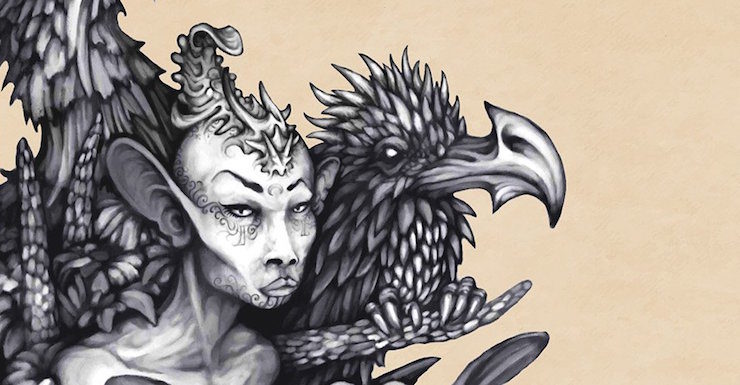Written by Sofia Samatar and illustrated by her brother Del Samatar, Monster Portraits is a short art-object of hybrid fiction/autobiography—about as interstitial as it gets—that “offers the fictional record of a writer in the realms of the fantastic shot through with the memories of a pair of Somali-American children growing up in the 1980s.” The text for this collaborative work was a prior finalist for the 2013 Calvino Prize; Rose Metal Press brings it to readers for the first time, filled with strange and alluring illustrations.
Monster Portraits serves the function of philosophy, or poetry: the text makes offerings, sketches connections, and requires leaps of juxtaposition as well as freefalls into implication. Each line is a treat to be savored and allowed to meld with its companions over a slow, methodical, reverential reading experience. The “happening” of the text is not located in the plot where our protagonist-author collects interviews and sketches of various monsters but in the lyrical, metaphorical weight of those vignettes taken in concert.
Buy the Book


Monster Portraits
I was reminded, in reading Monster Portraits, of Maggie Nelson’s The Argonauts. Both books are immensely intertextual, grounded in personal narratives that are married to the language and logic of academia. I also appreciate that both texts provide their references rather than setting the bar of entry so high that the reader who isn’t already familiar can’t access the pleasure of the work. However, for those readers who come from a similar background in theoretical/critical pursuits, the deft weaving of text into text into text is a heady pleasure.
To be direct about the whole thing, I was overcome with a desire to wallow in this book as if it were a pile of warm, home-smelling blankets. There are monsters here and there is also monstrousness, two things that are connected but not united. The monster—the abject, the outsider—has long been associated with otherness, in terms of race or gender or sexuality or embodiment. Samatar, in this brief collection of vignettes, forms a thematic argument about her own experiences of being and encountering the monster (and also of encountering the monstrous).
Again, I’ll say that each line is a slow pleasure. I read Monster Portraits twice in a row, in one sitting, forcing myself to take it in sips each time even though I wanted to gulp. For example, in “The Collector of Treasures,” which deals in part with being broken down into component parts as an act of violence, Samatar writes: “In the realm of language, the opposite of a monster is a catalogue.” The monster has ambiguity, trauma, crevices; the catalogue has been rendered into its parts by force. Reading the vignettes in this book, it is not possible to point to a single phrase or line that creates the totality of the emotional and philosophical effect, but it’s possible to isolate certain moments of impact.
The section that struck me the most was “The Clan of the Claw.” The concept of clan, of being a united portion of a larger whole, is juxtaposed with the experience of oppression and suffering. Our writer-protagonist says, “What is the truth of feeling? Without wishing to conflate or appropriate, I feel myself in the clan of Alan Turing dying of cyanide poisoning.” She repeats the phrase “without wishing to conflate or appropriate” across several other examples of egregious treatment of minorities, including Sarah Baartman and Walter Benjamin and Mariam Yahia Ibrahim. In doing so, she sketches the sameness and difference of their realities, their traumas, their horror. What has been done to them is monstrous; the monstrous and the monster are separate categories.
“Monsters of the Fairy Kingdom,” which comes near the end, is a single page. Samatar’s protagonist reflects in exhaustion, considering the idea of the parasite: “What does it even mean to embrace your nature? Surely it can’t mean explaining it all the time.” The protagonist is a writer, tired of the act of creating and explaining an inexplicable category of identity, being forced again and again to tread the same paths of conversation about her race, her gender, et cetera.
Which also brings me to the conceptual work Monster Portraits does with its theory, its fantasy, and its autobiography. Three strands of narrative bind into a tight braid of reflection on the idea of the monster: for instance, what it means to exist in a society that others its members so frequently and with such vitriol. Or, what it means to embrace otherness. As she writes, “The monster is monstrous only insofar as it enables the monstrous act.” In discussions of genocide, of race-based violence, of gender oppression and sexual trauma, the act is monstrous and is often committed against those occupying the social role of monster/other.
There are also the small things that drove me to heights of delight in reading this book: the fact that Cixous exists in the same realm as a place where the protagonist might have hotel neighbors who bang the plating on their tails together to distract her, for example. The blurring of boundaries between writer and written, protagonist and author, genre and academy—all of these things too. The pleasure of the monster is the pleasure we find here in these portraits, as well as fear and sympathy and pain.
The Samatar siblings have created a work of art, and I adored it.
Monster Portraits is available from Rose Metal Press.
Lee Mandelo is a writer, critic, and editor whose primary fields of interest are speculative fiction and queer literature, especially when the two coincide. They have two books out, Beyond Binary: Genderqueer and Sexually Fluid Speculative Fiction and We Wuz Pushed: On Joanna Russ and Radical Truth-telling, and in the past have edited for publications like Strange Horizons Magazine. Other work has been featured in magazines such as Stone Telling, Clarkesworld, Apex, and Ideomancer.










